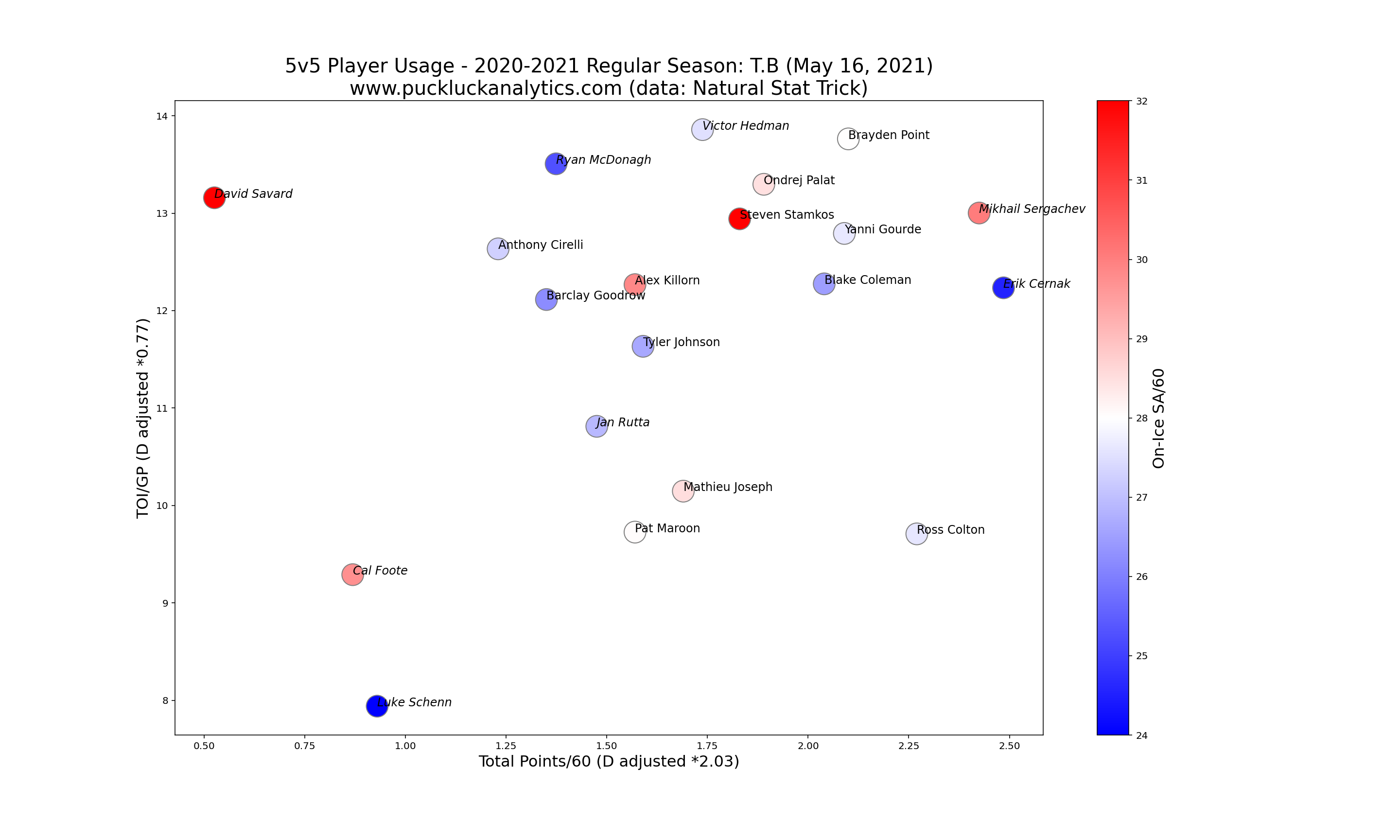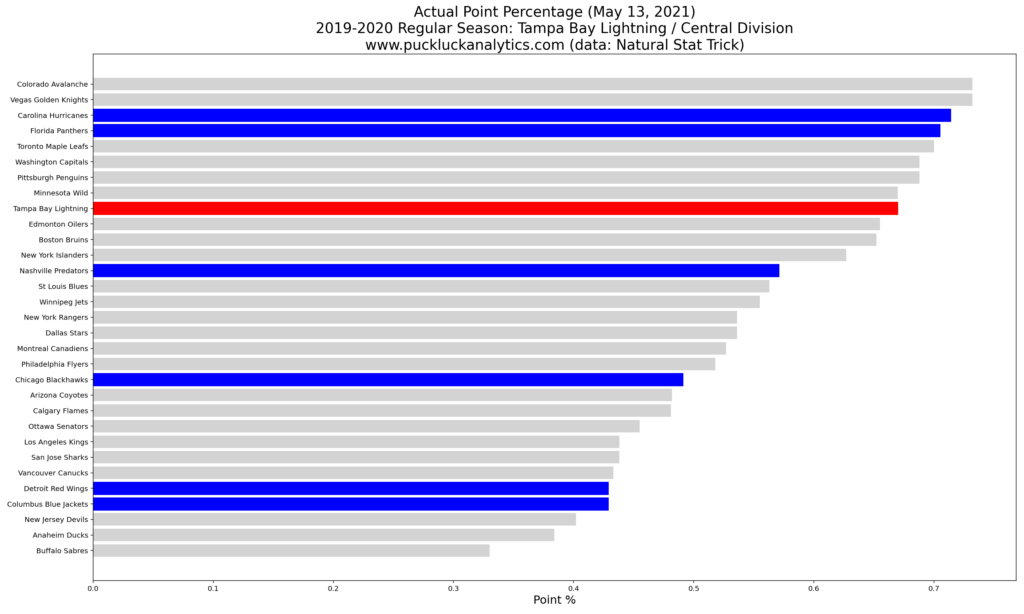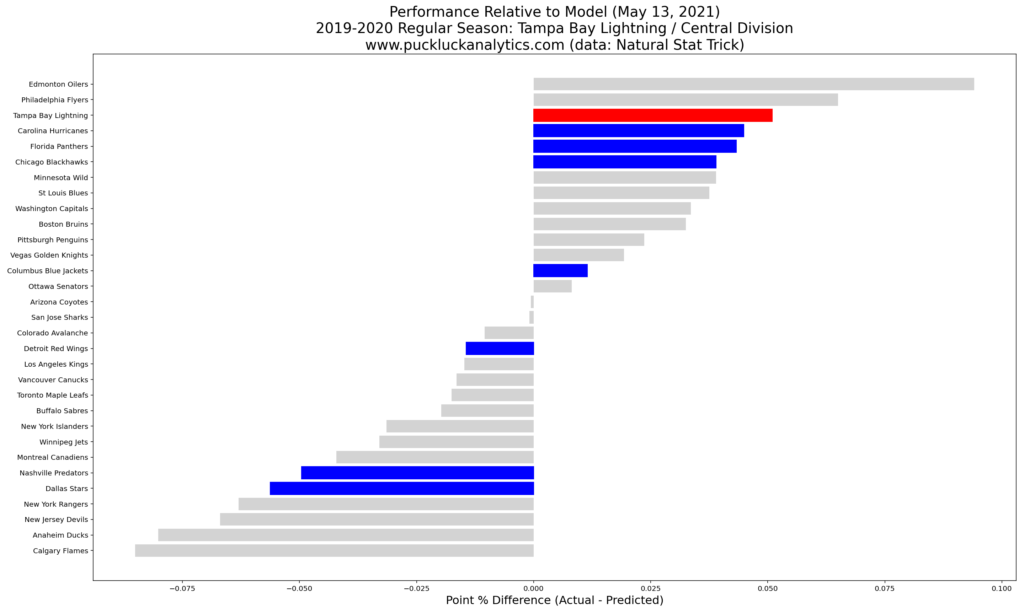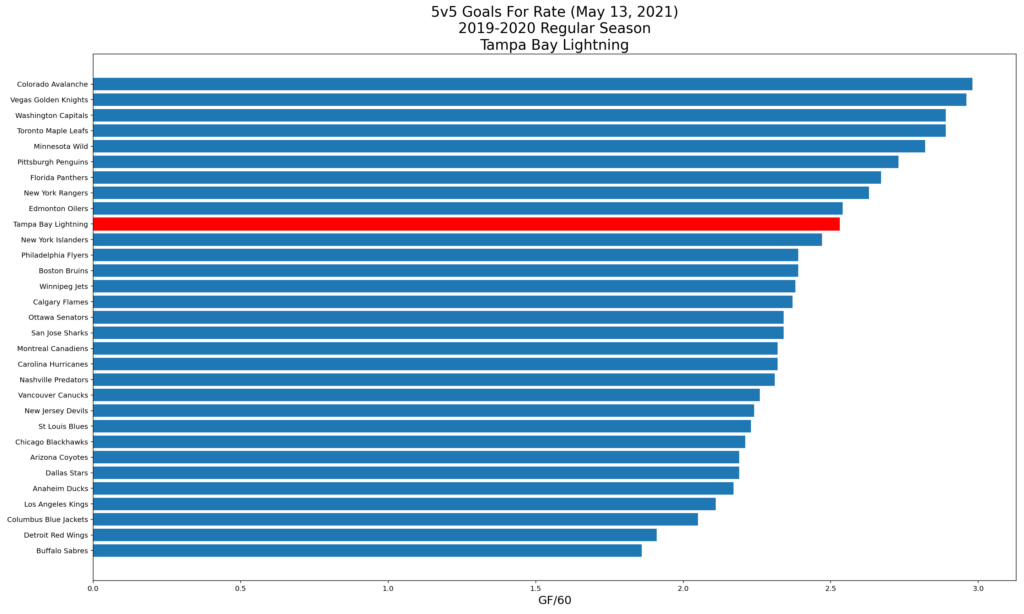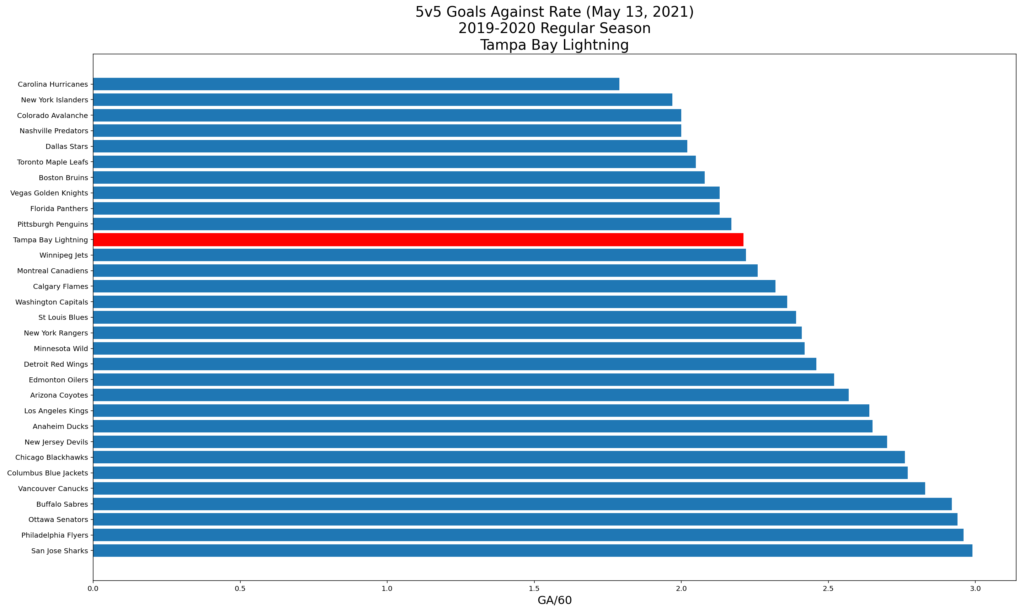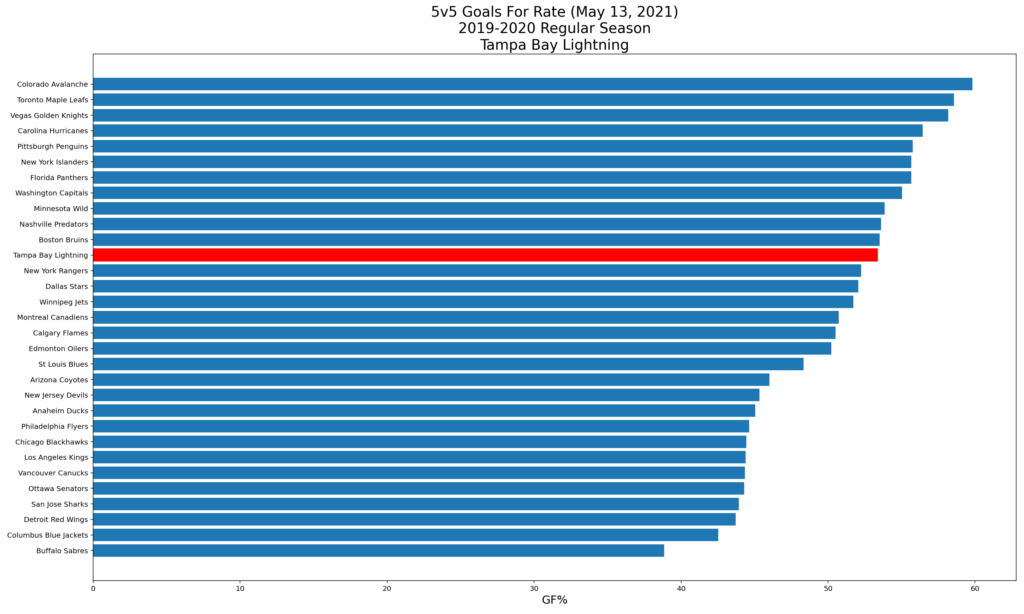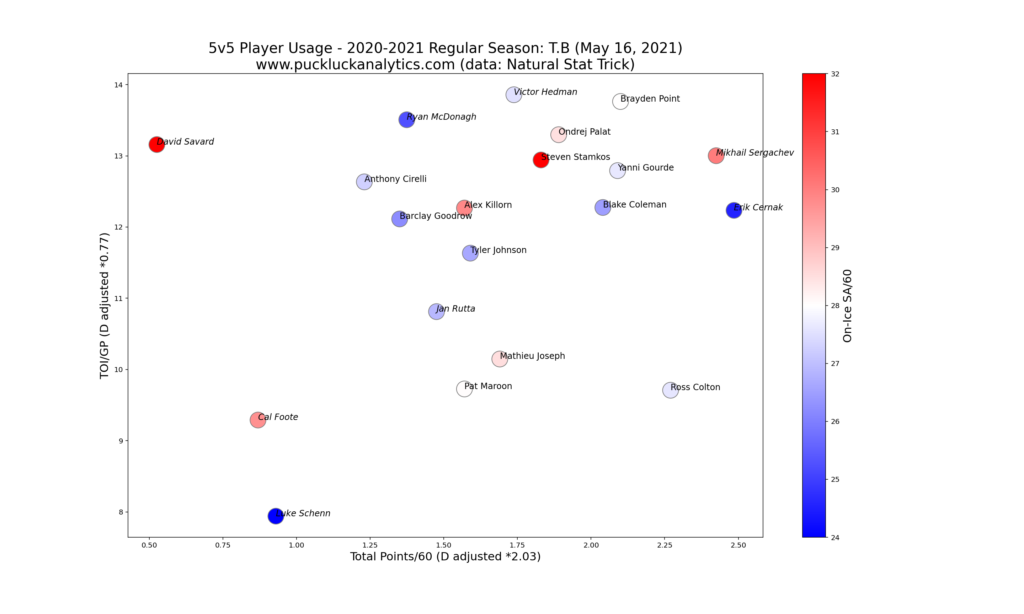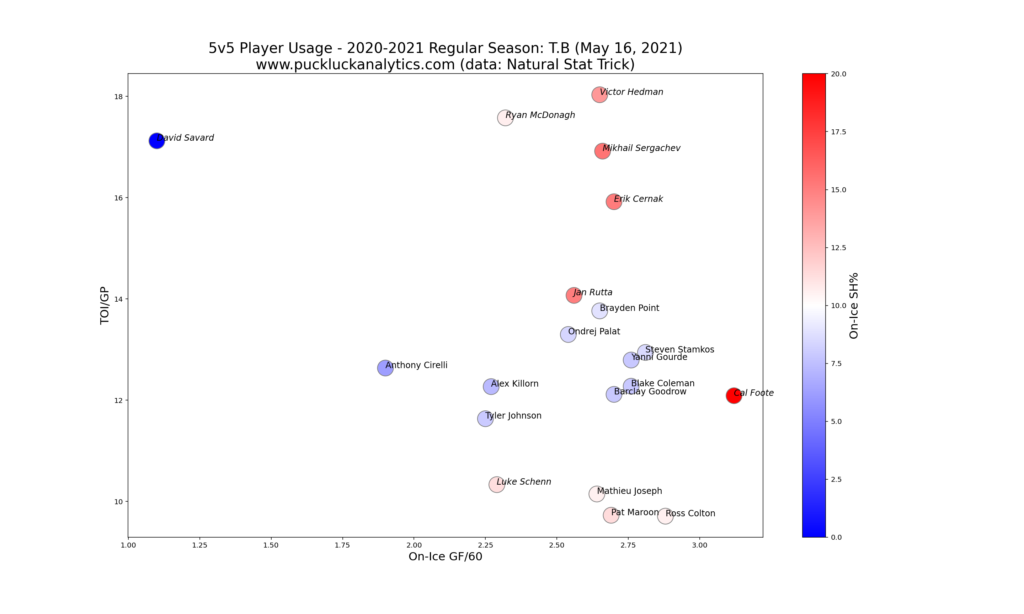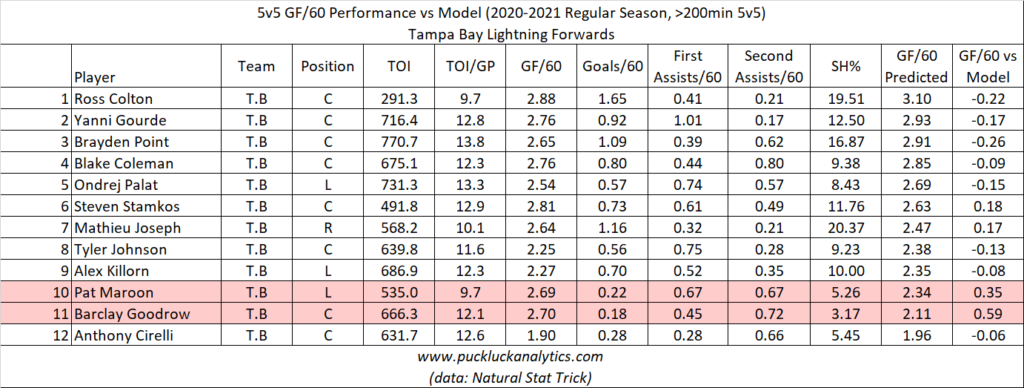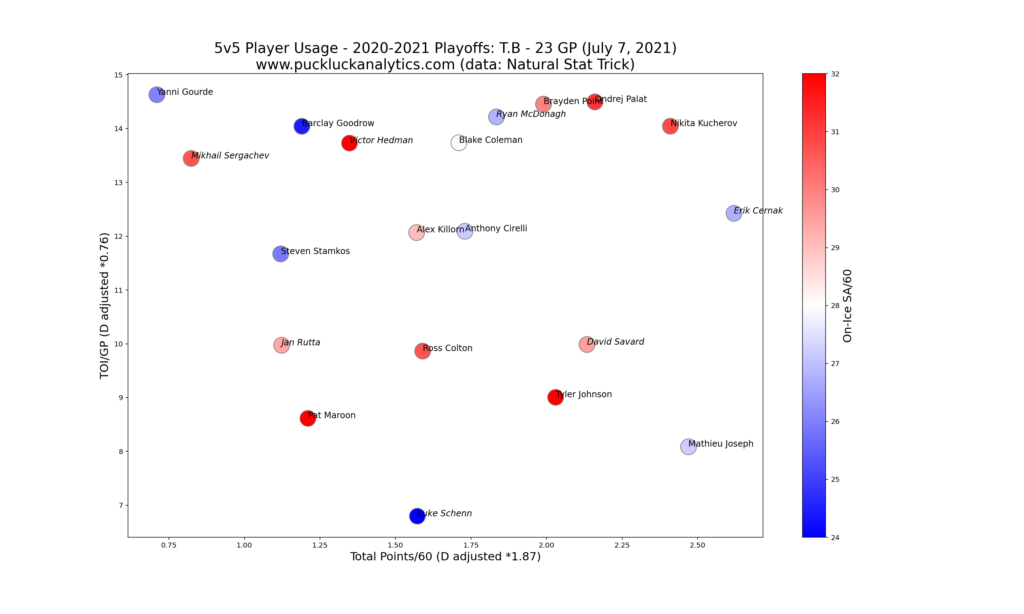The Tampa Bay Lightning are the 2020-2021 Stanley Cup Champions. With back-to-back cup wins, the Bolts are now unquestionably the team to beat as they eye a three-peat in 2021-2022. Let’s take a look at their season. If you haven’t already, I recommend reading this post for some additional detail on the plots we’ll look at.
Overall Performance (Regular Season)
The Lightning were strong throughout the regular season, although they had competition in the Central Division. They finished behind both the Hurricanes and Panthers as the third seed in the division. Let’s take a look at how our points predictor model rates them based on 5v5 goal rates.
While they were 3rd in the Central Division, our points predictor model drops them one spot to fourth. The Lightning outperformed the model by the most in the division, although with similar variance as the Canes and Panthers. This suggests their 5v5 play did not fully explain their results. Special teams and overtime results are the most likely reasons for the variance.
Let’s take a look at the Bolts’ 5v5 goal rates that feed into the model.
The Lightning were not elite either offensively or defensively in the regular season, however they were competent in both areas leading to a respectable goal for percentage.
Player Performance (Regular Season)
We’ll start looking at player performance with a 5v5 usage chart. Stats for defensemen have been factored for direct comparison with forwards. The result is a visual depth chart where we should see players distributed along a diagonal with the top players in the top right.
While there is a rough diagonal distribution, it’s quite wide. This suggests that Tampa could have used their skaters more effectively. For example, Ross Colton is well below the diagonal suggesting he was under-utilized while Anthony Cirelli is above the line suggesting he may have been over-utilized.
By plotting 5v5 on-ice GF/60 vs TOI/GP, we get a visual depiction of the relative offensive contributions from each skater. Players further up and right on the plot had greater impacts on team GF/60.
The most interesting thing here is the nearly perfect vertical distribution of all the Lightning skaters. The offensive impact did not change much at all throughout the lineup, which speaks to the depth the Lightning have. Cirelli, Tyler Johnson and Alex Killorn look like the less impactful skaters offensively, but it’s not by a large margin.
Plotting 5v5 on-ice SA/60 vs TOI/GP give us a similar visual for defensive contributions. Here, players further left and down had better impacts.
The majority of Tampa’s skaters sit relatively tightly grouped slightly below the league average of 30 SA/60. Steven Stamkos is an interesting outlier, with significantly worse defensive impact. David Savard and Mikhail Sergachev stand out among defensemen with worse shot suppression than their teammates.
Next, we’ll use our on-ice GF/60 models to assess which players appear to have carried their line mates offensively, or were carried by their line mates. To do this, we’ll focus on the variance between the model output and actual. Variances greater than 0.3 are of interest and negative variance suggests a player carrying his line mates.
Looking at the forwards, we see that most of the variances from the model output are quite small. This suggests that the Lightning forwards generally all pulled their weight offensively. Pat Maroon and Barclay Goodrow are the only exceptions. Both had very low shooting percentages this season, which drags down the model and is a reason for some of the variance. As a whole, we can see that there were no passengers in this forward lineup.
We see a similar phenomenon with the Bolts’ defensemen. The variance from the model for the top defensemen is quite small. Cal Foote and Luke Schenn appear to have been carried offensively by their line mates, although Schenn is just barely at our threshold for interest. David Savard appears to have carried his line mates offensively, however we can theorize that to be more due to his impact in Columbus prior to the trade deadline.
Andrei Vasilevskiy was a wall for the Lightning this season, putting up very strong numbers at 5v5. If there is an area the Bolts could look to improve for next season, it’s backup goaltending. They had sub 0.900 save percentage from their second and third string goalies at 5v5 which simply isn’t good.
Playoff Performance
While the 23 game sample is quite small, we can still gain some insight into the Lightning’s playoff run by looking at a 5v5 usage chart.
The data is quite scattered on this plot, but we can see there were no passengers for the Bolts on their playoff run. They received production from throughout the lineup and their depth appears to have been a strong factor in their success.
Looking Ahead
The Lightning head into the offseason about $4M over the salary cap. There will certainly be some turnover of their roster in order to meet the salary cap before the puck drops on the 2021-2022 season.
Key RFAs:
The Lightning have few pending RFAs that finished the season at the NHL level. Ross Colton may be the most notable after scoring the Stanley Cup winning goal in game 5 of the finals.
Key UFAs:
The Bolts have a handful pending UFAs, with Blake Coleman headlining the list. With their current cap position, the Lightning will be hard pressed to keep Coleman and will have to move out salary elsewhere if they plan to. David Savard is the biggest name on the blueline that will be looking for a new deal over the summer.
Key Players Under Contract:
The Lightning had strong performances from some of their depth players with smaller cap hits. This is certainly true on defense where Sergachev, Erik Cernak and Jan Rutta were important pieces. If the Bolts continue to get strong performances from players chewing up small pieces of the cap, it bodes well for their future success.
Tough Questions:
Which players can the Lightning most afford to lose in order to fit under the cap for the 2021-2022 season? While it looks likely that their pending UFAs will wind up in different colors next season, the Bolts still have to move out some additional salary to become cap compliant.
Offseason Priorities:
We saw the Lightning have a strong team with good depth. The obvious weakness this season was their backup goaltending, which they should look to address during the offseason. Aside from that, they’ll need to carefully manage their roster to keep it in tact to the extent possible while squeezing under the salary cap.
This is the final season review for the 2020-2021 season. Check out the other reviews, such as the Montreal Canadiens and the New York Islanders. I hope you’ve had as much fun reading them as I had putting them together.
data: Natural Stat Trick
cap data: CapFriendly
